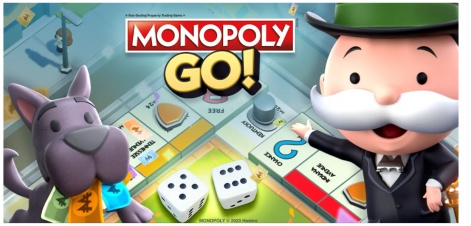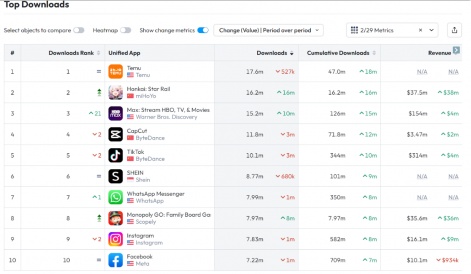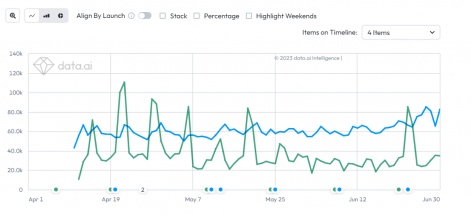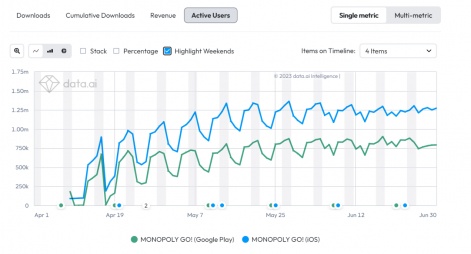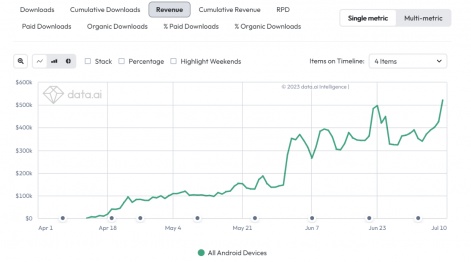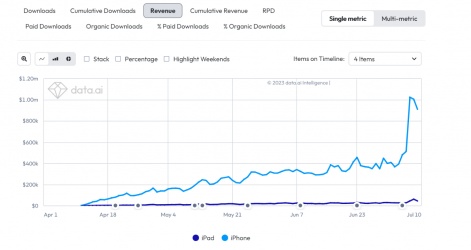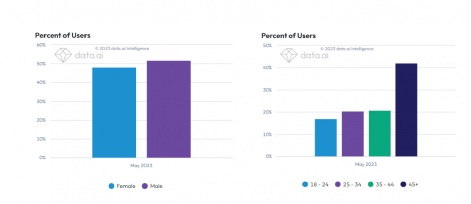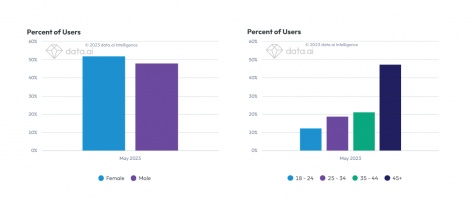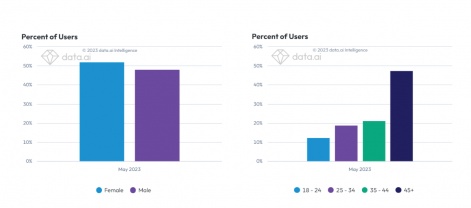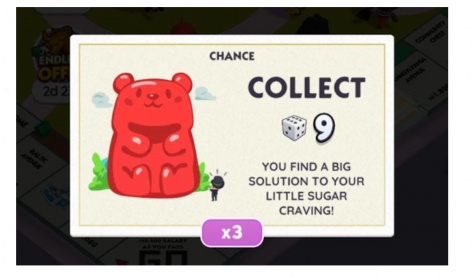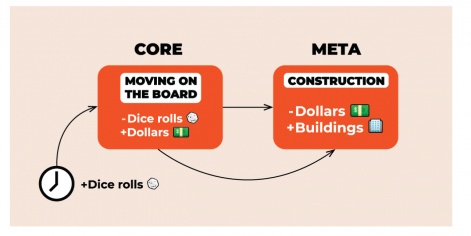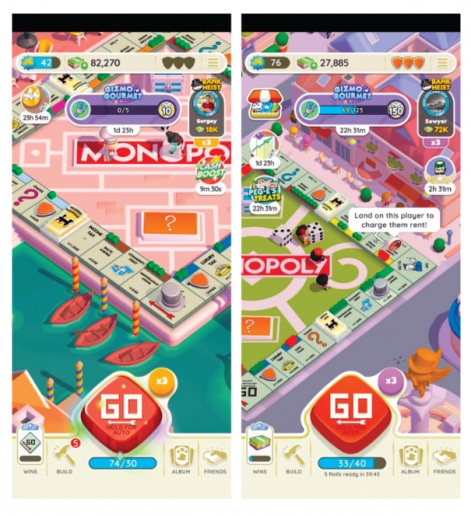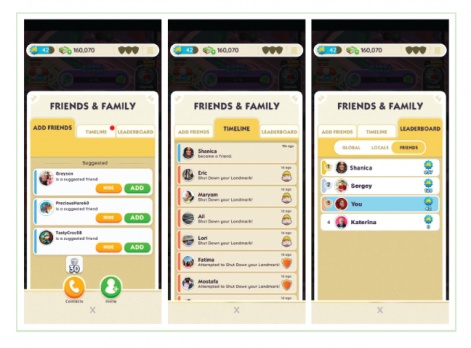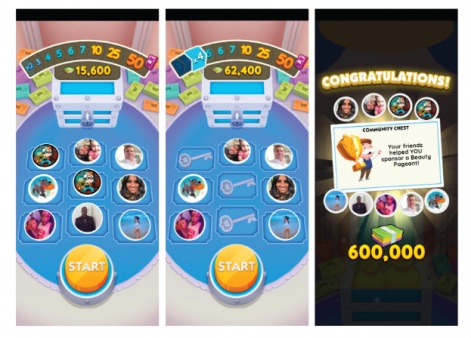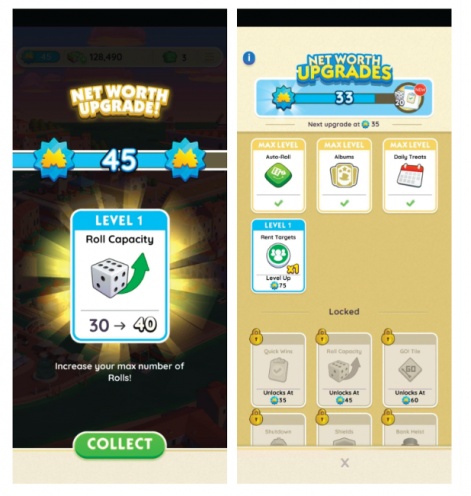Scopely’s Monopoly GO! Launched on April 12 and has since gone on to achieve massive success. The game uses a unique blend of the Monopoly formula that everyone knows and loves and adapts it to work as a solo experience on the mobile platform. The game quickly reached the top of the charts and made waves as the top casual launch of 2023.
In this guest article game designer Irene Kurskaya looks under the hood of Monopoly GO! And breaks down what makes this twist on a classic board game work on mobile.
Everyone knows Monopoly as a family game – or, to be exact, “a game that can tear any family apart.” A game of Monopoly can last hours. It’s hard to imagine how you could possibly translate its fun but lengthy gameplay into a mobile game.
But people have tried, and in all kinds of different genres too, from a digital board game to a mashup of different game mechanics:
What’s So Interesting About It? Let’s Look at the Metrics.
Metrics
The only Monopoly game to become a top-ranking app is Monopoly GO! It’s just behind Netflix in terms of installs. Sure, Monopoly Go! is a new app, and its entire target audience hasn’t installed it, but the numbers are still pretty impressive.
Downloads may have stabilised since the natural peak they reached during the game’s global launch, but they haven’t exactly gone down to zero.
The number of active users has stabilised, but it’s worth noting that the game managed to smooth out the inevitable weekday-weekend gap, maintaining approximately equal user activity throughout the week.
Alongside the continuous stream of downloads, daily revenue is growing. Starting from the 4th of July, the daily revenue for iOS has more than doubled, which could be indicative of successful events in honour of Independence Day in the USA.
Demographics
Monopoly GO!’s demographics are interesting. According to Data.ai, the Android version was played by more men than women in May 2023 (no data is available for iOS). The dominant age group is 45+.
However, the game’s competitors’ stats are somewhat different. For example, Board Kings has a primarily female audience, but it also has fewer young players.
The same goes for Coin Master.
So on average, Monopoly GO!’s audience is younger and more male.
On the Shoulders of Giants
Fans of chance-based clicker games might notice that Monopoly GO! is inspired by Board Kings and Coin Master. The first game’s influence can be seen in how Monopoly GO! deals with the board: dice rolls with multipliers, train stations for going to other players’ cities, etc. Coin Master is also the inspiration for its construction-based meta-gameplay: like Coin Master, Monopoly GO! lets the player build a few buildings in a themed town or city, and other players can destroy them.
But all the mechanics Monopoly GO! brings together have also been refined and adjusted to suit its overall vision. In fact, it sometimes seems like they actually work better here than in the games they were borrowed from.
We’ll go over some of the coolest features in a bit, but first let’s take a look at Monopoly as a whole.
The Sticky Wicket
Monopoly is a competitive board game. You can’t play it by yourself, and it has to end with one of the players winning. Monopoly GO!, however, is a single-player game. So how can it recreate the most exciting things about classic Monopoly, like bankrupting a friend or getting a real estate monopoly?
The answer is simple: everybody’s a winner.
Core + Meta
Monopoly GO! is a clicker game in which players roll dice, move across the game board, and build buildings.
Its core mechanic is moving the player’s piece across the board. The player pushes a button to roll the dice, spending dice rolls to do so. The game does everything else by itself. The piece hops across the board and initiates various reactions from the board when it stops.
The player has very little bearing on what happens since everything is determined by random chance. The game only limits the number of dice rolls the player can purchase. However, Monopoly GO! focuses the player’s attention on social mechanics – some competitive, some cooperative. For example, the “Community Chest” can’t be opened until the player has at least five friends.
The game’s developers have decided to use the classic Monopoly board but surround it with themed decorations. The Venice board has a charming gondola dock, and the Paris board has beret-wearing Parisians strolling across it. The boards in Board Kings are decorated in a similar way.
On the board, the player earns “dollars” to advance in the meta-game, which means building buildings, getting houses, and increasing rent.
Houses, which are granted for building buildings in the player’s “town,” aren’t reset when you move to a new board. The player keeps them until they build one hotel on each monopoly space and get a bonus. Only then do the houses reset, and the player can build another monopoly.
By the way, this sets Monopoly GO! apart from Coin Master, where towns don’t give the player anything other than satisfaction and an opportunity to show off their progress.
Starting Sessions and What’s Good about Them (Spoiler: Everything)
During the first play session, every clicker game tries to convince the player that it’s a dopamine factory: everything is fast and beautiful, with lots of rewards and colourful animations.
- The game lets the player play through the first two cities very quickly, drowning them in rewards and refusing to let them go – they’ve still got so many dice rolls left!
- The social mechanics come into play right away – I’ll go into more detail about them later, but Monopoly GO! does a great job of solving the problem of players who don’t have any in-game friends.
- The session ends when the player is tired out but satisfied. They’ve done all their dice rolls and beaten two cities, and pretty soon, their friends will start coming to check out their board.
Standout Features: Friends and Contacts
The devs really put their experience with clans, co-op, and other mid-core staples to work and borrowed from browser-based social media games. Monopoly GO! regularly offers to add strangers who are active in the game to the player’s friends list. You can do it right in the HUD, without even going to a social media app.
The friends list itself first takes you to a tab with suggestions for new friends, THEN shows you the friends you already have. This motivates players to expand their contact list by adding more active players. It deepens the player’s interaction with the game’s features, fills their timeline with events, and gives the leaderboards meaning since it’s hard to compare your progress with that of other players if you don’t have any friends.
Raids
When the player’s piece lands on the Train Station space, they get on a train and visit other players, but not with the best of intentions. There are a few different options for gameplay mechanics here: players can destroy buildings, block other players, or raid them. This last option is, in my opinion, more fun and exciting than in Board Kings, which is our main point of reference here.
In that game, the player sees four boxes and is asked to pick three (Coin Master has the same mechanic for digging up treasure). But it’s much more interesting in Monopoly GO! The player is given a 4×3 board, and each tile can contain one of three different items: coins, bills, or rings. The player reveals spaces until they find three of the same item, then gets a corresponding reward: coins (small reward), bills (medium reward), or rings (the biggest reward).
So what makes this more attractive than what the game’s competitors are offering? The ability to choose from a larger number of options increases engagement and gives the player more opportunity for strategy (it’s still random, but it’s more fun for the player to choose). It’s also important to note that the player sees the potential outcomes right away and can tell which has the highest probability – an indicator on the right side of the screen shows how many of each item the player has found. This keeps things interesting and makes each subsequent choice more important.
Community Chest
The Community Chest has a timer in the middle of the board. This feature is not available until the player adds five or more friends.
The player is given a 3×3 board with a friend’s avatar on each tile. With each turn, the player presses a button that reveals a random tile. A key replaces the avatar on that tile and the reward multiplier increases. If the algorithm lands on an unrevealed tile with a key, the game ends, and the player gets a reward with the multiplier they managed to accumulate. On top of that, the player whose avatar was on the tile with the chest-opening key gets dice rolls as a reward, and a notification about this is sent to their newsfeed.
Sometimes a bonus reward appears for the helper, which is marked by a chest on that player’s avatar.
Everything about this feature rocks. The involvement of friends, the reward multiplier (every click is more intense than the last), and, of course, the ability to get a reward for helping your friends even if you weren’t actually playing the game at the time.
From a meta-gameplay perspective, it’s a fantastic way to get the player to allow notifications from the game – they don’t want to miss out on the next chest, after all.
Network Level/Player Level
The great thing about the player’s level in Monopoly GO! is that it’s more than just a bar with benefits; it’s also a tab with pictures of rewards. It’s different in Board Kings: you get the reward of your choosing (which is awesome), but you don’t know what the rewards are or when you’ll get them.
Thanks to the visualisation used in Monopoly GO!, the player always knows what they will get at each level. It’s just like a skill tree or card collecting. All the information is laid out in a simple, easy-to-understand screen that can be accessed from anywhere.
Levelling up doesn’t just increase your traditional stats like dice roll regeneration and maximum dice rolls; it also increases your Daily Bonus, enhances your Raid and Cover features, and adds new Chance cards. These factors keep the game interesting for experienced players and show newcomers how the gameplay will develop over time.
The developers have managed to combine progress and collecting, albeit as a visualisation. This really speaks to players.
Graphics and Music
A game about getting rich definitely shouldn’t look cheap. Monopoly GO! looks like a well-made, modern game while still paying homage to the classic board game’s design. The music and sound effects are worth mentioning too. Every clicker developer knows how important sound effects are for pumping out that dopamine. Monopoly GO! really hits the jackpot here – the dollar bills have a delectable rustling sound, the dice bounce off the table in a way that gets your heart racing – all the sound effects work toward total sensory immersion in the gameplay.
Monetisation
When it comes to monetisation, Monopoly GO! isn’t taking any big risks. You get new-player offers with big discounts during the first few play sessions, and then multi-slot offers with several free options start appearing at the beginning, usually with dice rolls and currency. Trigger offers appear when the player runs out of dice rolls.
Since monetisation is primarily connected to regular and situational offers, the game’s Bank is more decorative than anything else. However, it’s still necessary to show the player what a great deal the special offers are.
Some of the offers can only be purchased a limited number of times. These are mostly seasonal offers linked to holidays that are positioned as amazing deals, but in practice, they’re really just one more way to put pressure on the player.
Conclusion
The developers of Monopoly GO! have managed to strike a balance between preserving Monopoly’s classic look and rule set and adapting it into a mobile clicker game. They haven’t shied away from borrowing mechanics from other games, but they’ve also developed them and made them more fun and exciting (as with Raids).
Needless to say, Monopoly GO!’s greatest strength isn’t just that it offers something unique to each type of player (achievement-oriented players, collectors, etc.). This game doesn’t just have features to check off boxes – they all have value, and they all work to retain the player. And if you’ve got good retention, you’ve got plenty of monetisation opportunities.
As experienced social game developers (Yahtzee® with Buddies Dice is a good example), the creators of Monopoly GO! have found a way to take a clicker and substantially develop its social essence beyond the usual “invite a friend to get a reward” or “destroy the building to tick your friend off.” They’ve managed to create a system in which the more friends you have, the more rewards you get, and those rewards are always doled out on a regular basis.
Maybe this explains the explosive growth in installs the game has experienced since its release and beyond – players want to play it solo and with friends because it really is more fun to play together. And this famous IP looks like it’ll be sticking around for a long time to come – after all, everybody knows that Monopoly is a fun, time-tested franchise.
Edited by Paige Cook

